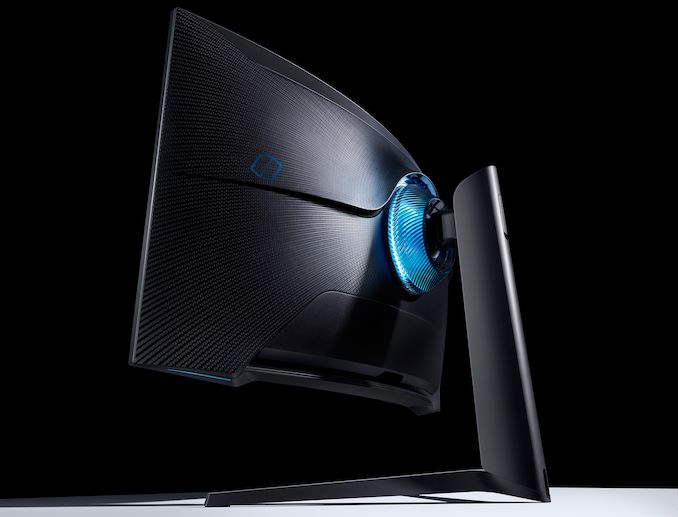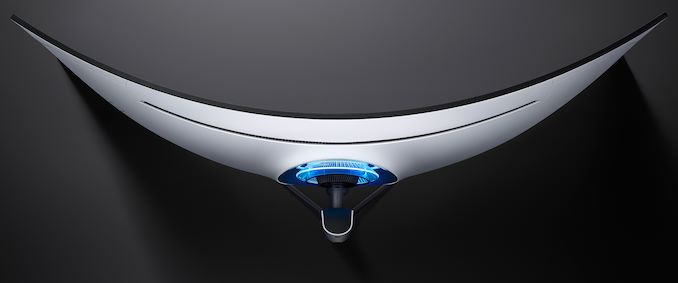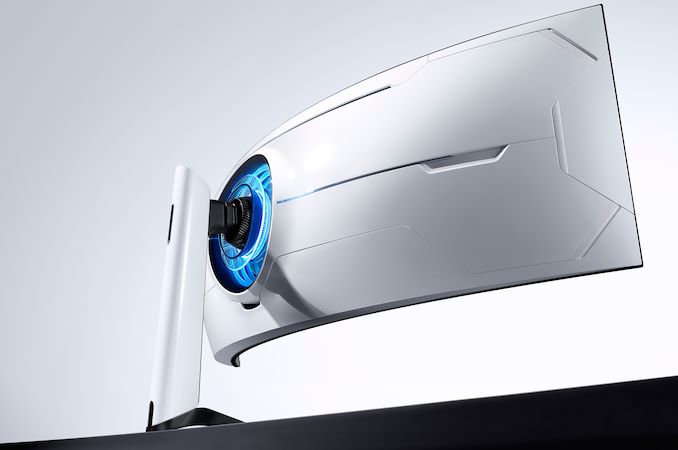Samsung’s Odyssey Continues: Ultra-Curved QLED 49-Inch 240 Hz HDR1000 Monitor w/ Adaptive Sync
by Anton Shilov on January 16, 2020 12:00 PM EST
Nowadays, you can barely impress a gamer with just a curved display. So when Samsung started development of its new Odyssey G9 and Odyssey G7 gaming monitors, it decided to make them ultra-curved, ultra-fast, ultra-bright, and ultra-futuristic. As a result, the new Odyssey LCDs for gamers feature a unique combination of a 1000R curvature, a quantum dot enhanced backlighting, and variable refresh rate support up to 240 Hz.
Samsung’s Odyssey gaming displays lineup includes three models: the 49-inch G9 featuring a 32:9 aspect ratio and a 5120×1440 resolution, as well as the 32-inch and 27-inch G7s featuring a 16:9 aspect ratio and a 2560×1440 resolution. All three monitors use a VA panel with a QLED (quantum dot-enhanced LED) backlighting that enables 600 nits or 1000 nits peak brightness, along with a wide color gamut (see general specifications of the displays in the table below).
From a gamer’s perspective, the key features of the Samsung Odyssey displays are their 240 Hz refresh rate, complete with variable refresh rate support. Samsung's specifications don't make this entirely clear, but it looks like the display uses VESA Adaptive Sync, meaning that it's supported with both AMD and NVIDIA GPUs.
Meanwhile, the monitor also sports a 1000R curvature that promises to enable better immersion when compared to regular curved LCDs.
Since the Odyssey monitors are designed for gamers, they feature an ultra-futuristic design along with LED-based lighting on the back to emphasize features of the design and just follow the general industrial trend.
| General Specs of Samsung's Odyssey Displays with Variable Refresh | |||
| Odyssey G9 49-Inch |
Odyssey G7 32-Inch |
Odyssey G7 27-Inch |
|
| Panel | 49" VA | 32" VA | 27" VA |
| Native Resolution | 5120 × 1440 | 2560 × 1440 | |
| Maximum Refresh Rate | 240 Hz | ||
| Response Time | 1 ms | 1 ms | 1 ms |
| Brightness | 1000 cd/m² | 600 cd/m² | |
| Contrast | high | high | high |
| Backlighting | LED w/Quantum Dots | ||
| Viewing Angles | 178°/178° horizontal/vertical | ||
| Curvature | 1000R | ||
| Aspect Ratio | 32:9 (3.56:1) | 16:9 | |
| Color Gamut | DCI-P3 sRGB |
||
| Dynamic Refresh Rate Tech | VESA Adaptive-Sync (NVIDIA G-Sync Compatible) |
||
| Pixel Pitch | 0.234 mm² | 0.2767mm² | 0.2335 mm² |
| Pixel Density | 108.54 PPI | 91.79 PPI | 108.79 PPI |
| Inputs | DisplayPort HDMI |
DisplayPort HDMI |
DisplayPort HDMI |
| Audio | ? | ? | ? |
| USB Hub | ? | ? | ? |
| MSRP | ? | ? | ? |
Samsung will make its Odyssey G9 and Odyssey G7 displays available sometimes in early second quarter, which is why the company does not publish all specifications and characteristics of the products just now. Prices of the monitors will be revealed at launch.
- Samsung Announces CRG9: A 49-Inch Curved 5K 120 Hz FreeSync 2 Monitor
- Samsung Announces First Freesync 2 Monitors: CHG70 & CHG90 - Quantum Dots, Up to 49”, 144 Hz, DCI-P3
- Samsung Odyssey Z Gaming Notebook: Going For Gamers with 8th Gen and Max-Q
- CES 2019: Samsung Announces The Notebook Odyssey
- Samsung Announces Updated Notebook 9, Odyssey, and Chromebook Plus/Pro
Sources: Samsung Canada, Samsung India, Samsung U.S., TFT Central














31 Comments
View All Comments
prophet001 - Thursday, January 16, 2020 - link
nahp1esk - Thursday, January 16, 2020 - link
I wonder how we drive 5120 × 1440 at 240Hz? Two DP1.4 cables?mukiex - Thursday, January 16, 2020 - link
Raw bandwidth for 4:4:4 5120x1440@240hz would be 53 gigabits.4:2:0 subsampling will get you to ~27 gigabits, under the DP1.4 limit. But that's at 8bit.
https://www.anandtech.com/show/10325/the-nvidia-ge...
Realistically, I don't think you're gonna get it done without an RTX or higher, given the probably need for DSC.
https://www.anandtech.com/show/13346/the-nvidia-ge...
mukiex - Thursday, January 16, 2020 - link
Ugh, I meant "probable need". Muscle memory is hard to fight while typing sometimes.p1esk - Thursday, January 16, 2020 - link
4:2:0 is crap, I'd much rather use DSC, but it's not clear if this monitor supports it.imaheadcase - Thursday, January 16, 2020 - link
You don't. a gamer is not expecting that high during gaming. I have a 35 and 38inch monitors. One is 35 is 120Hz and other is 60hz. I prefer the 60Hz just because its higher rez and looks so much better in games like Red Dead 2. In fact i don't even notice a difference after switching over to the 60Hz because what people don't understand its not just the monitor its the games visuals that matter.p1esk - Thursday, January 16, 2020 - link
I have two Asus PG27UQ (4k@144) driven by 2060 Super card, and I have zero interest in gaming. But I'd rather have a single monitor like this one, provided it had both high DPI and high refresh rate. Yes, I realize the DPI on this one is crap, but it's a step in the right direction.lilkwarrior - Saturday, January 18, 2020 - link
You're better off getting a true 4K ultrawide like what LG already provides then.nevcairiel - Thursday, January 16, 2020 - link
I heard that Samsung invented their own "HDR1000" branding for these, which is in fact NOT related to the DisplayHDR 1000 certification - indicating that the HDR performance is in fact going to be quite weak.I don't suppose anyone can confirm this?
nevcairiel - Thursday, January 16, 2020 - link
Not to mention that buying such an expensive screen right now, (hopefully) a year before we get DP2.0 or HDMI 2.1 to actually be able to drive them properly, would just be silly.